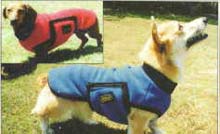Top Five Winter Hazards for Your Pets …
How to Keep Your Dog and Cat Safe
by www.SixWise.com
Do heavy snowfalls, icy winds and freezing temperatures make you want to crawl under the covers and hibernate until spring? Your cat and dog probably feel your pain. For many pets, the winter season brings with it a unique set of challenges and dangers -- hazards you can avoid with a bit of preparation and knowledge.
|
Want to Give Your Pet the Longest, Healthiest, Happiest Life Possible?

Choose healthy, natural pet food and treats from GreenerWiener.com!
At Greener Wiener their mission is simple: to provide natural pet products that promote wellness for dogs and cats.
Greener Wiener believes your pets deserve healthy food and treats, and toys made from non-toxic materials. They believe the Earth deserves a break too, which is why they actively seek out products made from safe, environmentally friendly materials.
Visit GreenerWiener.com now to view their unique line of all-natural pet products to enhance the health and well-being of your furry little ones.

|
"Animals rely solely on their human caregivers for safety and comfort -- especially during the winter months," said Betsy McFarland, HSUS senior director of companion animal on HumaneSociety.org. "Our pets are particularly vulnerable during this frigid season, and with just a few extra precautions you can help make sure that they stay safe and healthy."
Top 5 Winter Dangers for Your Pets
1. Cold Temperatures
Dogs and cats left outdoors can easily freeze or suffer from frostbite. Outdoor cats may also crawl under the hoods of cars for warmth, where he may become injured or killed by the fan belt (for this reason always bang on the hood of your car before starting your engine if it’s left outside). Even leaving your dog or cat in the car for a few minutes can be deadly during the winter, as the vehicle can hold in cold air, acting as a refrigerator and causing your pet to freeze to death.
Cats should be kept inside during the winter, and dogs should be kept inside except during supervised exercise. If you have a short-haired breed, keep in mind that the cold can still be damaging, even for short walks.
Covering your dog with a coat or sweater that offers protection from the base of the tail to the belly is a simple way to keep your dog safe from winter weather, and help him enjoy his winter walks and potty time.
One high-quality and super warm dog coat that Sixwise.com highly recommends is Apache River Dog Coats from GreenerWiener.com.
These coats will keep your dog cozy, warm and dry on even the coldest winter days. Manufactured by Norman Equine Designs, a premier maker of horse blankets, these coats impressed us because of their lightweight, yet super-warm, fabric and snug, ingenious fit.
The coat wraps around your dog's chest and belly, something many other dog coats are lacking, and they come in regular and LONG sizes to fit a variety of dogs.
These coats are made of fleece fabric with a full lining and are designed to hug your dog's body like a second layer of fur. Plus, they are a cinch to take on and off: just slip over your dog's head, bring the breast flap through the front legs, then attach the (incredibly strong) Velcro to the body on each side.
2. Getting Lost
More dogs are lost during the winter than any other season, according to the ASPCA. Why? Because snow and ice cover up the scents your dog is used to, and this means they can easily lose their scent and become lost.
So avoid letting your dog off lease in snow or ice, and always make sure her ID tags are fastened securely to her collar.
|

Apache River Dog Coats from GreenerWiener.com are snuggly, super warm and have an ingenious fit. Made by the manufacturers of top-notch horse blankets, these coats can even be custom fit to your individual dog. Learn more now!
|
3. Antifreeze Poisoning
As you winterize your car, be sure to stow antifreeze safely out of pets’ (and children’s) reach, and wipe up any spills thoroughly. This toxic poison has a sweet taste that attracts pets, but ethylene glycol-based antifreeze can be deadly. Switching to a propylene glycol-based antifreeze is a good choice, as although these can still harm pets they are less toxic than other coolants.
4. Salt and Snow-Melting Chemicals
Salt and other chemicals used for snow and ice removal can irritate your pet’s paws and may be harmful if ingested. Ideally, avoid walking your dog where these chemicals have been placed. If it cannot be avoided wipe your pet’s paws immediately when you come indoors using a moist cloth. There are pet-friendly ice melts available, and these are far safer for your pets.
5. Changing Food Needs
If your pet spends a lot of time outdoors in the winter, he’ll burn through calories faster trying to stay warm. So he may need to be given more food -- particularly protein-rich food -- in cold months in order to generate this body heat and stay nourished. This is especially true if your pet lives outdoors or exercises heavily outside. And as always, the higher quality food you feed, the better off your pet will be.
Recommended Reading
What’s Really in Your Dog’s Food? Top Reasons Why Your Pet’s Food Could be Slowly Killing Him
Dental Care for Pets: Do You Need to Brush Your Dog’s Teeth, Too?
Pet Obesity is Now the Leading Cause of Preventable Death in Dogs and Cats
Sources
HumaneSociety.org December 7, 2009
ASPCA.org